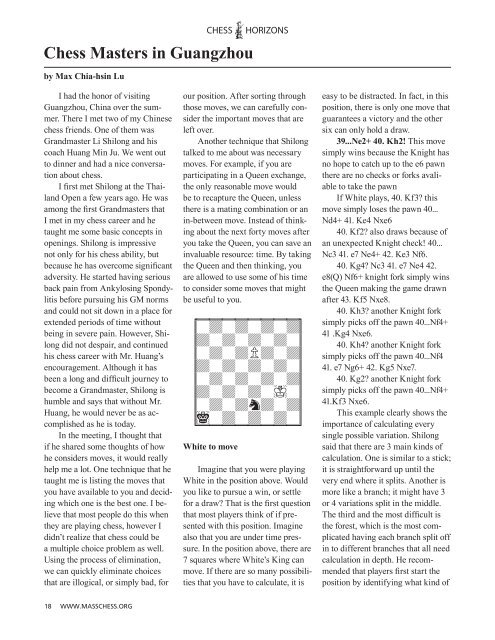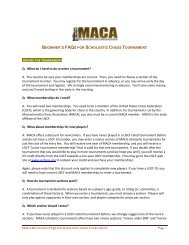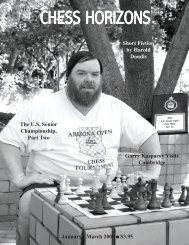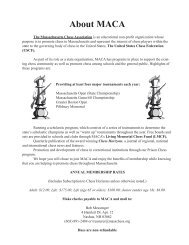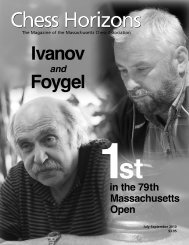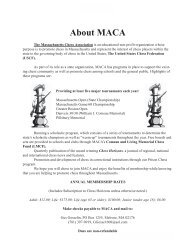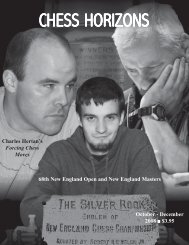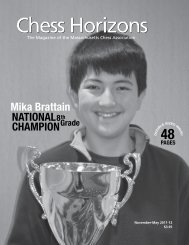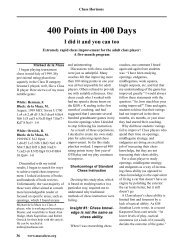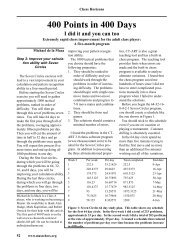Chess Horizons - The Massachusetts Chess Association
Chess Horizons - The Massachusetts Chess Association
Chess Horizons - The Massachusetts Chess Association
You also want an ePaper? Increase the reach of your titles
YUMPU automatically turns print PDFs into web optimized ePapers that Google loves.
<strong>Chess</strong> Masters in Guangzhou<br />
by Max Chia-hsin Lu<br />
I had the honor of visiting<br />
Guangzhou, China over the summer.<br />
<strong>The</strong>re I met two of my Chinese<br />
chess friends. One of them was<br />
Grandmaster Li Shilong and his<br />
coach Huang Min Ju. We went out<br />
to dinner and had a nice conversation<br />
about chess.<br />
I first met Shilong at the Thailand<br />
Open a few years ago. He was<br />
among the first Grandmasters that<br />
I met in my chess career and he<br />
taught me some basic concepts in<br />
openings. Shilong is impressive<br />
not only for his chess ability, but<br />
because he has overcome significant<br />
adversity. He started having serious<br />
back pain from Ankylosing Spondylitis<br />
before pursuing his GM norms<br />
and could not sit down in a place for<br />
extended periods of time without<br />
being in severe pain. However, Shilong<br />
did not despair, and continued<br />
his chess career with Mr. Huang’s<br />
encouragement. Although it has<br />
been a long and difficult journey to<br />
become a Grandmaster, Shilong is<br />
humble and says that without Mr.<br />
Huang, he would never be as accomplished<br />
as he is today.<br />
In the meeting, I thought that<br />
if he shared some thoughts of how<br />
he considers moves, it would really<br />
help me a lot. One technique that he<br />
taught me is listing the moves that<br />
you have available to you and deciding<br />
which one is the best one. I believe<br />
that most people do this when<br />
they are playing chess, however I<br />
didn’t realize that chess could be<br />
a multiple choice problem as well.<br />
Using the process of elimination,<br />
we can quickly eliminate choices<br />
that are illogical, or simply bad, for<br />
our position. After sorting through<br />
those moves, we can carefully consider<br />
the important moves that are<br />
left over.<br />
Another technique that Shilong<br />
talked to me about was necessary<br />
moves. For example, if you are<br />
participating in a Queen exchange,<br />
the only reasonable move would<br />
be to recapture the Queen, unless<br />
there is a mating combination or an<br />
in-between move. Instead of thinking<br />
about the next forty moves after<br />
you take the Queen, you can save an<br />
invaluable resource: time. By taking<br />
the Queen and then thinking, you<br />
are allowed to use some of his time<br />
to consider some moves that might<br />
be useful to you.<br />
cuuuuuuuuC<br />
{wdwdwdwd}<br />
{dwdwdwdw}<br />
{wdwdPdwd}<br />
{dwdwdwdw}<br />
{wdwdwdwd}<br />
{dwdwdwIw}<br />
{wdwdndwd}<br />
{iwdwdwdw}<br />
vllllllllV<br />
White to move<br />
Imagine that you were playing<br />
White in the position above. Would<br />
you like to pursue a win, or settle<br />
for a draw? That is the first question<br />
that most players think of if presented<br />
with this position. Imagine<br />
also that you are under time pressure.<br />
In the position above, there are<br />
7 squares where White’s King can<br />
move. If there are so many possibilities<br />
that you have to calculate, it is<br />
easy to be distracted. In fact, in this<br />
position, there is only one move that<br />
guarantees a victory and the other<br />
six can only hold a draw.<br />
39...Ne2+ 40. Kh2! This move<br />
simply wins because the Knight has<br />
no hope to catch up to the e6 pawn<br />
there are no checks or forks avaliable<br />
to take the pawn<br />
If White plays, 40. Kf3? this<br />
move simply loses the pawn 40...<br />
Nd4+ 41. Ke4 Nxe6<br />
40. Kf2? also draws because of<br />
an unexpected Knight check! 40...<br />
Nc3 41. e7 Ne4+ 42. Ke3 Nf6.<br />
40. Kg4? Nc3 41. e7 Ne4 42.<br />
e8(Q) Nf6+ knight fork simply wins<br />
the Queen making the game drawn<br />
after 43. Kf5 Nxe8.<br />
40. Kh3? another Knight fork<br />
simply picks off the pawn 40...Nf4+<br />
41 .Kg4 Nxe6.<br />
40. Kh4? another Knight fork<br />
simply picks off the pawn 40...Nf4<br />
41. e7 Ng6+ 42. Kg5 Nxe7.<br />
40. Kg2? another Knight fork<br />
simply picks off the pawn 40...Nf4+<br />
41.Kf3 Nxe6.<br />
This example clearly shows the<br />
importance of calculating every<br />
single possible variation. Shilong<br />
said that there are 3 main kinds of<br />
calculation. One is similar to a stick;<br />
it is straightforward up until the<br />
very end where it splits. Another is<br />
more like a branch; it might have 3<br />
or 4 variations split in the middle.<br />
<strong>The</strong> third and the most difficult is<br />
the forest, which is the most complicated<br />
having each branch split off<br />
in to different branches that all need<br />
calculation in depth. He recommended<br />
that players first start the<br />
position by identifying what kind of<br />
18 WWW.MASSCHESS.ORG


